Article
Clinical Outcomes of Oral Anticancer Regimens in NSCLC Patients Managed in an Integrated Health-System Specialty Pharmacy Program
Author(s):
Pharmacist interactions provide significant benefits for patients with non-small cell lung cancer treated with oral oncolytics.
Non-small cell lung cancer (NSCLC) treatments are rapidly evolving and there is an increasing number of oral oncology medications available for patients. The use of oral therapies present new challenges compared with intravenous (IV) therapy.
Adherence with IV therapy is ensured at each infusion in which staff prepare, deliver, observe, and document each treatment. With oral therapy, patients are responsible for taking their medication at home, where there is a risk for missed or forgotten doses, taking doses earlier or later than recommended, and not refilling medications.
Non-adherence has been associated with poor patient outcomes, such as reduced efficacy, higher rates of hospitalizations, and emergency department (ED) visits.1 To optimize adherence and outcomes, oral oncology medications require extensive patient monitoring and patient counseling.2,3
Previous studies have focused on adherence and financial considerations with these medications.4-10 These studies demonstrate the critical value pharmacists play within the workflow of patients receiving oral oncology medications.
Although oral oncolytic medications have produced impressive results in the setting of a controlled clinical trial in which adherence is closely monitored, more research in the form of real-world evidence (RWE) is needed to support these outcomes in the community. A recent published study reported that non-adherence rate of 13% among patients receiving erlotinib therapy for NSCLC from 2008-2013.11
Although this study provides a benchmark, it does not offer a full view of currently available oral medications for NSCLC, nor does it evaluate the use of medication therapy management by a URAC-accredited pharmacy program.11 Specialty medications are procured, distributed, and managed through a specialty pharmacy.
Each patient serviced by Novant Health Specialty Pharmacies receives comprehensive services including 24-hour access to our pharmacy team members, adherence management, enrollment with patient assistance programs and prior authorization, patient education and medication adverse effect counseling, and patient monitoring for safety and efficacy.
From this study, we aim to characterize treatment of patients with NSCLC with oral oncolytics at Novant Health and to describe the role clinical pharmacists play in patient education, care coordination, and adherence.
Methods
Trial design and patients
A single-center, retrospective, observational descriptive study was conducted of patients treated with an oral oncolytic for NSCLC at Novant Health. Patients were identified through the electronic health record (EPIC), specialty therapy management software (Therigy), and a prescription software system (QS1) if they received any of the therapies listed in Table 1 along with a diagnosis of NSCLC identified in the electronic health record (EHR). This study was approved as an exempt study by the Novant Health Institutional Review Board (IRB).
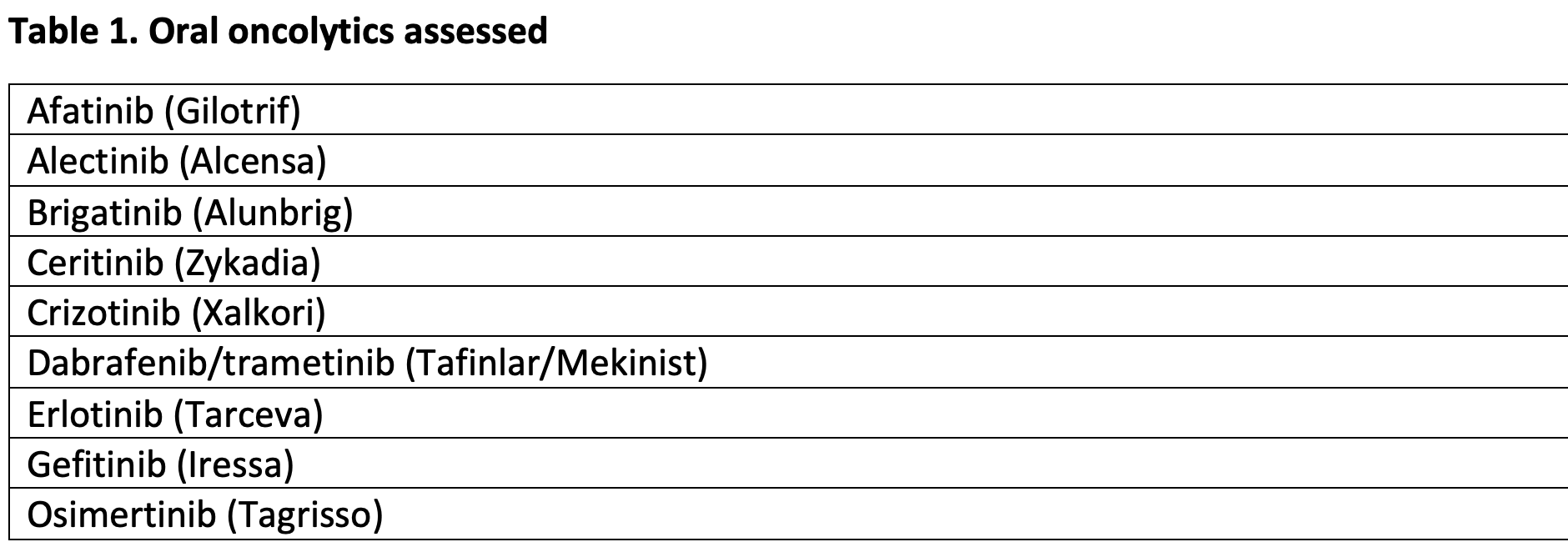
Novant Health Specialty Pharmacies consists of 2 pharmacies serving primarily North Carolina, Virginia, and South Carolina. Patient records from each of these pharmacies were reviewed to include adult patients with a diagnosis code of NSCLC and at least 1 mention of a targeted oral oncolytic in a clinical note or documented in the medications list within the EHR from January 1, 2017, to November 1, 2018. Patients under 18 years of age, no diagnosis of NSCLC, or who did not receive an oral oncolytic for NSCLC were excluded.
For the first phase of the study, information was collected from EPIC, which included patient characteristics, molecular information, clinical responses to therapy, and adherence to therapy. The following information was extracted specifically from EPIC:
- age
- race
- gender
- marital status
- zip code
- smoking status
- ECOG performance status
- date of first coded NSCLC diagnosis
- stage at initial NSCLC diagnosis
- stage at initial oral oncolytic mention
- date of first reported symptoms
- histology
- oral oncolytic length of therapy
- reason for discontinuation
- site of metastasis
- molecular variable status
- date of molecular variant test
- molecular variant test type (tumor or sputum)
- mutation type
- other mutation types
- testing location of pathology
- variant test before oral oncolytic mention in the database
- number of biopsies prior to molecular diagnosis
- prior NSCLC surgery
- prior NSCLC systemic chemotherapy
- prior lines of therapy before oral oncolytic mention in the database
- clinical response
- prescribed treatment after progression
For the second phase of the study, information was collected from Therigy and QS1, which included prescription history, toxicity assessment and management, care coordination, physician recommendations, patient counseling, refill reminders, lab assessments, drug-drug interactions, treatment modifications or discontinuations, financial toxicity, and quality of life screens. These combined sets enriched data from the abstraction of the electronic medical record.
Objectives
The primary objective for the study is to assess the number of pharmacist interactions per patient. Secondary objectives included estimation of adherence, progression-free survival (PFS), and duration of treatment.
Estimation of adherence was calculation using the medication possession ratio (MPR). MPR is calculated by the sum of days’ supply for all fills in period divided by the number of days in period, which is then multiplied by 100.
PFS was defined as the time between the first oral oncolytic to disease progression. Duration of treatment was defined as the time from the start of therapy to discontinuation.
Other objectives that were assessed was reasons for discontinuation of therapy and the outcome of the patient once the study ended.
Statistical analysis
Descriptive analysis was utilized for categorical variables, summary statistics was utilized for numerical data, and the Mann Whitney U test was utilized for continuous data.
Results
A total of 57 patients were identified via the EHR, of which 39 patients were included for final analysis. The reason for exclusion of 18 patients was due to age, no diagnosis of NSCLC, or no oral oncolytic taken.
Demographics
The average patient included in the study was 69.7 years of age (range 61-83), married (59%), Caucasian (71.8%), female (51.3%), with stage IV (67.6%) adenocarcinoma (92.3%) NSCLC being a non-smoker (46.2%) or former smoker (46.2%). A full list of baseline characteristics are described in Table 2.
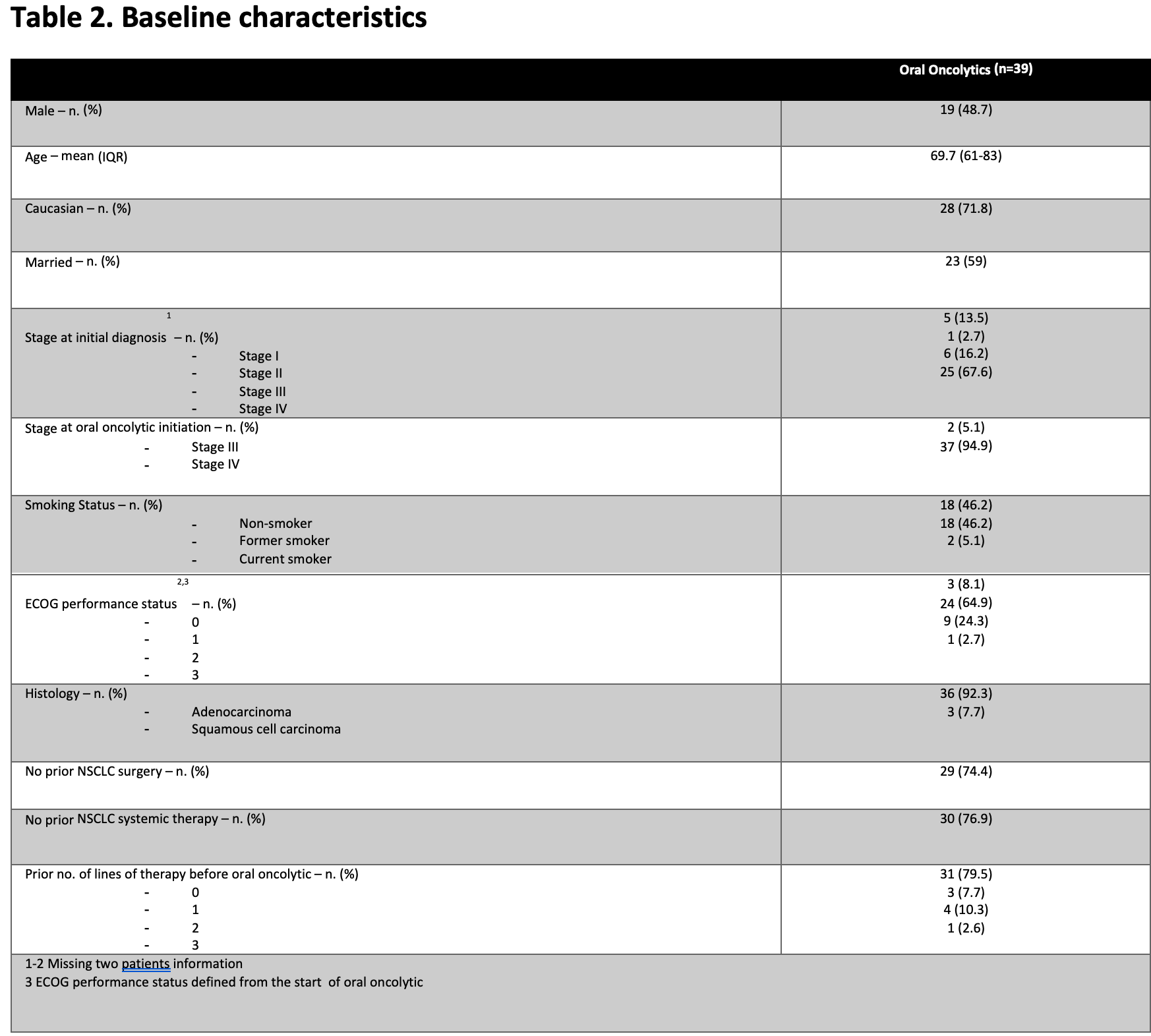
The most common primary mutation type for targeted oral oncolytics was EGFR (72.2%) this was followed by ALK (13.9%) and ROS1 (8.3%) as seen in Figure 1.
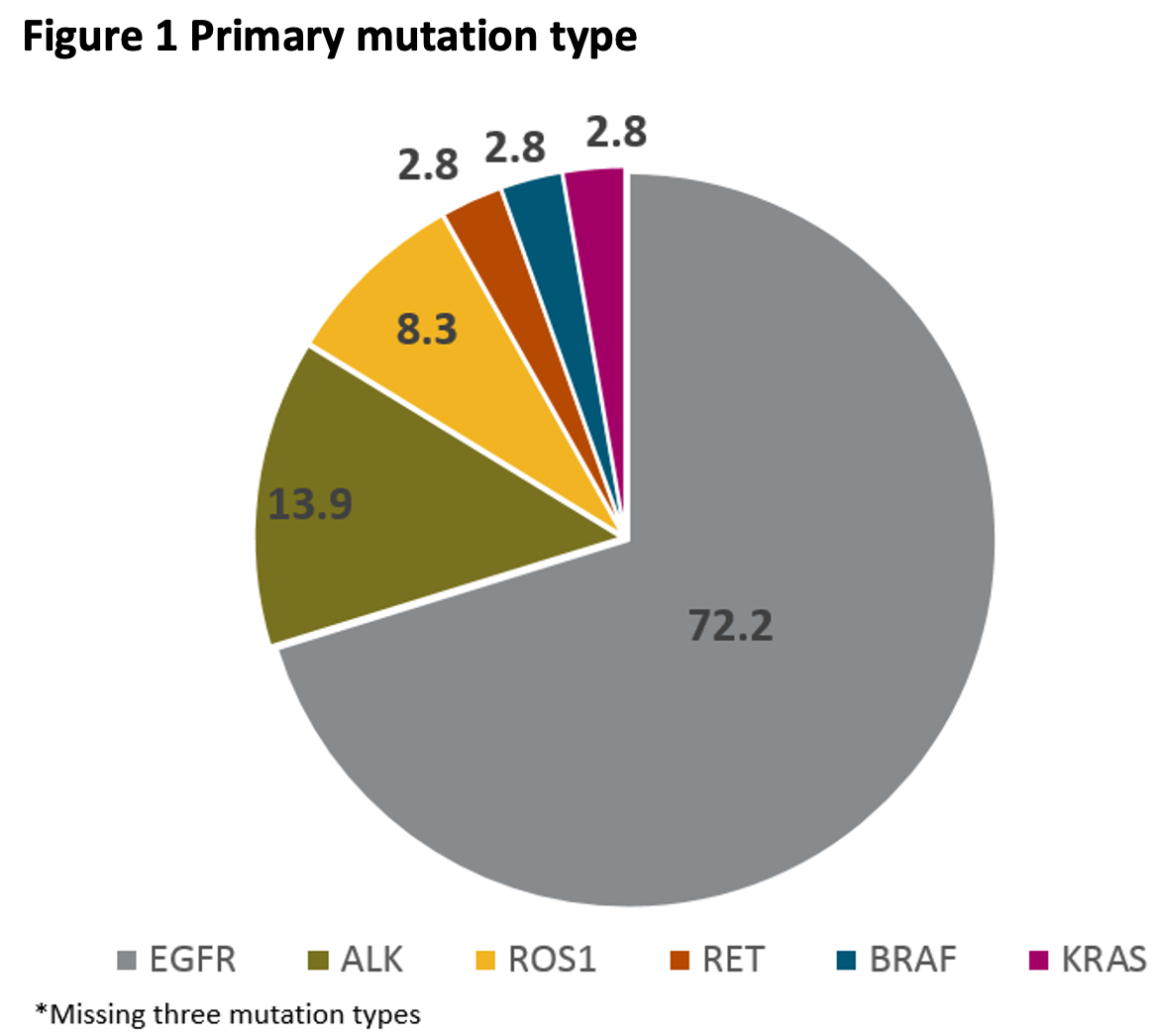
The most common secondary mutation types were TTF-1 (61.9%) followed by PD-L1 (61.9%) and CK7 (52.4%) as seen in Figure 2.
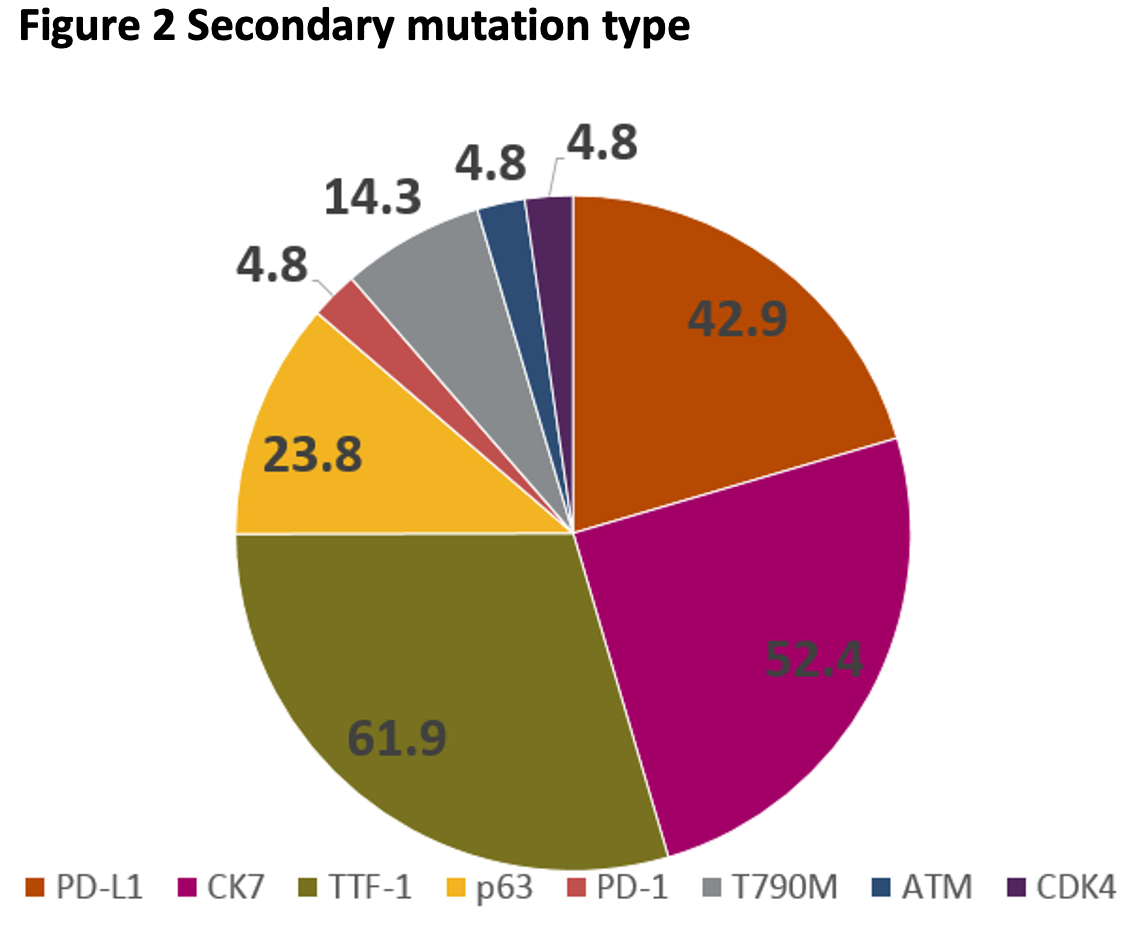
The majority of individuals received erlotinib (48.7%) followed by osimertinib (17.9%) as seen in Figure 3.

Molecular status was identified in 36 patients (92.3%) and this was usually performed before oral oncolytic mention (92.1%). Table 4 provides a further description of molecular information.
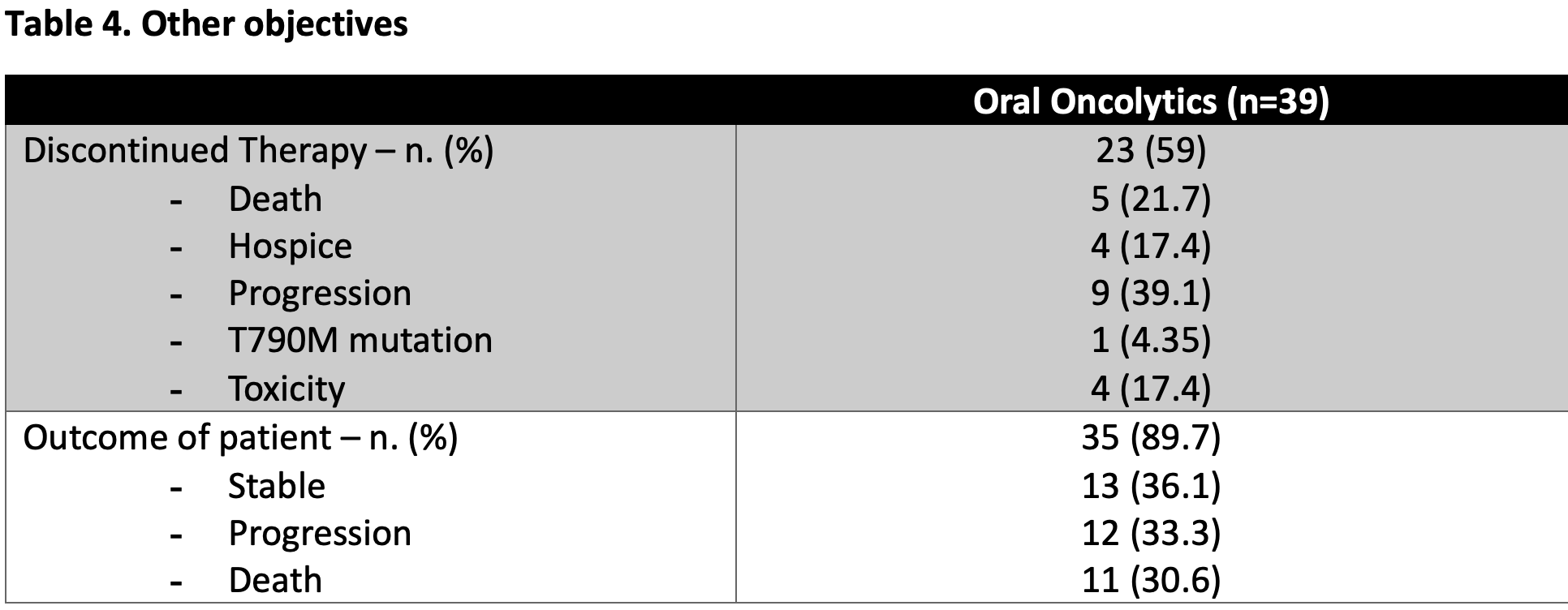
Primary objective
Pharmacist interaction per patient can be seen in Figure 4. From 39 patients, 25 (64%) had a pharmacist interaction from January 2017 to November 2018, which resulted in 655 interactions in total.
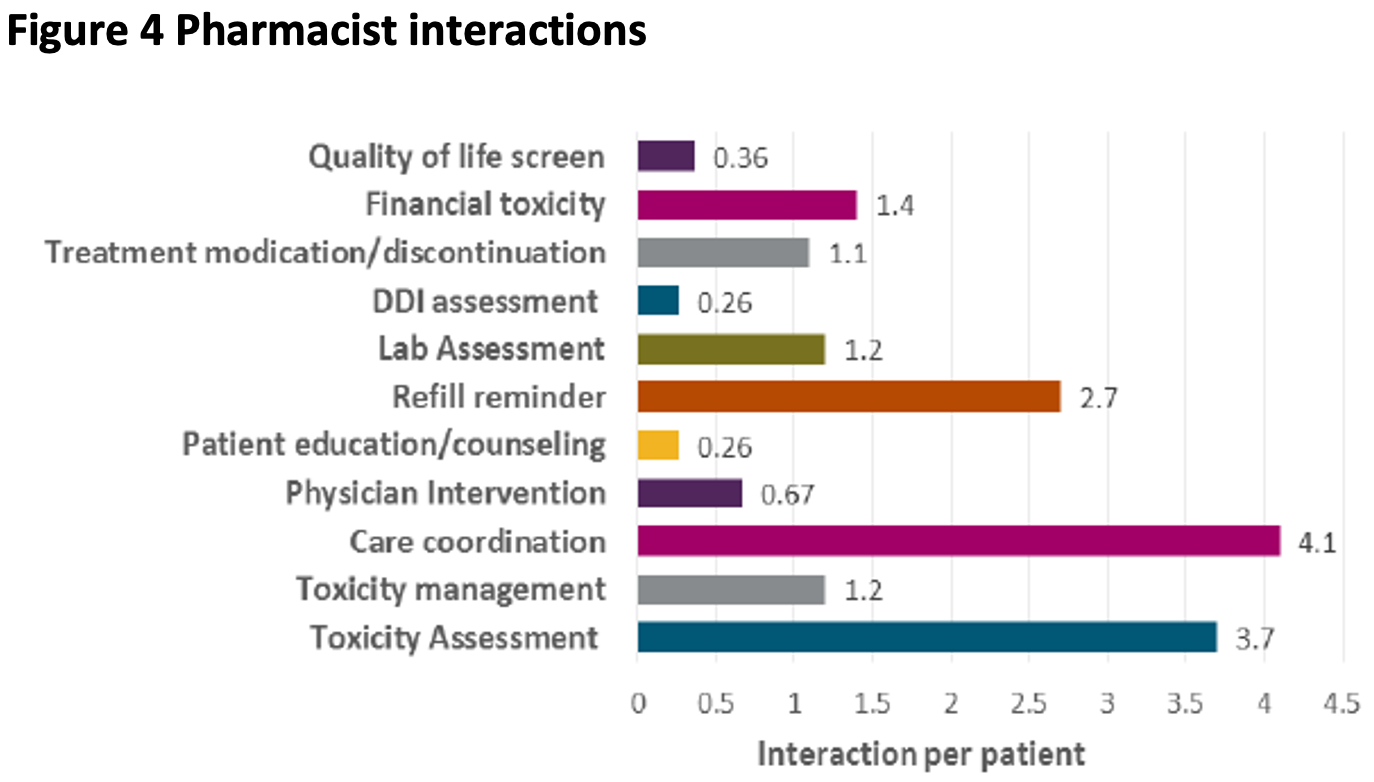
On average, 26.2 pharmacist interactions were seen per patient. The majority of interactions were done over the phone by the specialty medication pharmacist. Of the interactions, care coordination was the highest with 4.1 interactions per patient followed by toxicity assessment (3.7 interactions per patient).
Secondary objectives
Duration of treatment, MPR adherence, and PFS was assessed by pharmacist interaction and no documented pharmacist interaction as shown in Table 3 and Figure 5. This showed that when a pharmacist interacted with a patient that patients had a longer duration of treatment (761 days vs 396 days; p=0.0056).

However, MPR adherence and PFS was not affected by a pharmacist interaction. Interestingly, MPR adherence showed that there was a better adherence for patients with no documented pharmacist interaction (96.5% vs. 99.9%; p=0.126), which does not correspond to what other studies have shown.
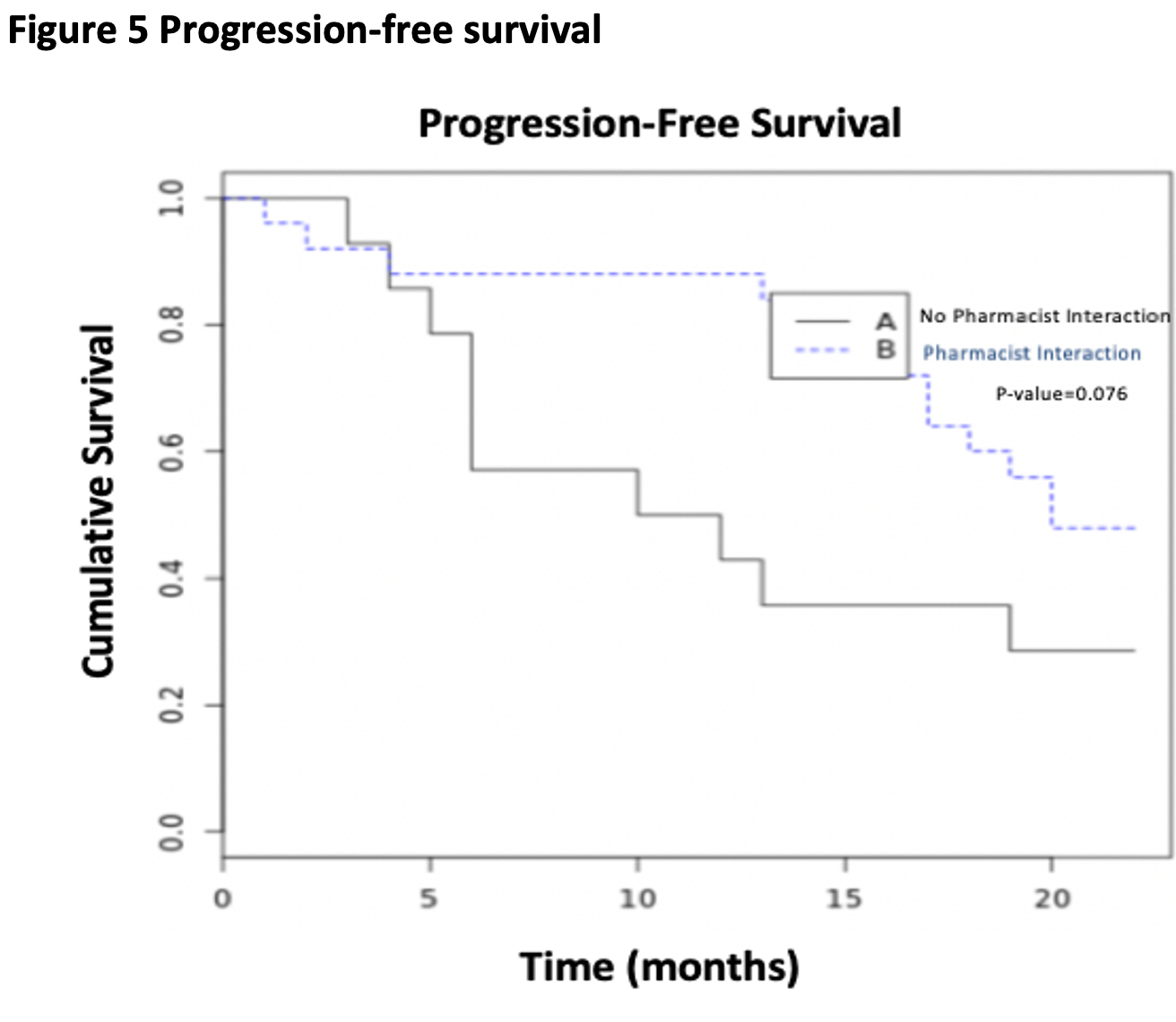
The Kaplan-Meier curve for PFS favored patients that received a pharmacist interaction, however, this did not show statistical benefit (p=0.076).
Other objectives
Of the 39 patients, 23 discontinued therapy mostly because of progression (39.1%) followed by death (21.7%). After study completion, 35 patients were found to have stable disease, progressive disease, or death.
The majority of patients had stable disease at the time of study completion (36.1%). A full description of these endpoints can be found in Table 4.
Discussion
This retrospective chart review provides a summative evaluation of interventions that pharmacists can make for NSCLC oral oncolytics. In our study, the average patient was similar to what is seen in clinical practice: middle age, Caucasian female with an EGFR mutation.
The duration of treatment for patients was also similar to an analysis of 5 clinical trials who had EGFR mutations and received TKIs. This trial showed a 67% response rate and 24-month overall survival.13
In our study, patients were on therapy for about 25 months if they had a pharmacist interaction. Previous studies have shown that a pharmacist can impact patients returning to a pharmacy for medication refills, which may lead to longer duration of treatment for patients.14
Although, MPR adherence did not correlate to pharmacist interaction we believe this is due to prescriptions not being filled within Novant Health.
Limitations
Limitations identified in this study include the lack of documentation regarding baseline characteristics and pharmacist interaction, descriptive findings that do not adjust for any baseline differences in those with versus those without pharmacist interactions, patients adherence was not assessed if prescriptions were transferred or filled at other pharmacies, and a small sample size was assessed.
Conclusion
In conclusion, this study provides a summation of the clinical benefit that pharmacist interactions can provide for patients with NSCLC treated with oral oncolytics at Novant Health. Pharmacists provided 655 interactions across 25 patients, which showed that these patients had a longer duration of treatment and PFS. More studies should be assessed to determine whether pharmacist intervention has an integral part in duration of treatment and adherence for all oral oncolytic therapy.
References
- Sokol M, McGuigan K, Verbrugge R, et al. Impact of medication adherence on hospitalization risk and healthcare cost. Med Care. 2005 Jun;43(6):521-30.
- Schwartz RN, Eng KJ, Frieze DA, et al. NCCN Task Force Report: Specialty Pharmacy. J Natl Compr Canc Netw. 2010;64(9)(suppl 5):S4-S7.
- Aisner J. Overview of the changing paradigm in cancer treatment: Oral chemotherapy. American Journal of Health-System Pharmacy. 2007;64(9 Supplement 5):S4-S7.
- Kavookjian J, Wittayanukorn S. Interventions for adherence with oral chemotherapy in hematological malignancies: A systematic review. Res Social Adm Pharm. 2015;11(3):303-314.
- Jabbour EJ, Kantarjian H, Eliasson L, et al. Patient adherence to tyrosine kinase inhibitor therapy in chronic myeloid leukemia. Am J Hematol. 2012;87(7):687–691
- Marin D, Bazeos A, Mahon F, et al. Adherence is the critical factor for achieving molecular responses in patients with chronic myeloid leukemia who achieve complete cytogenetic responses on imatinib. J Clin Oncol. 2010;28(14):2381–2388
- Noens L, van Lierde MA, De Bock R, et al. Prevalence, determinants, and outcomes of nonadherence to imatinib therapy in patients with chronic myeloid leukemia: the ADAGIO study. Blood. 2009;113(22):5401–5411
- Lam M, Cheung N. Impact of oncology pharmacist-managed oral anticancer therapy in patients with chronic myelogenous leukemia. Journal of Oncology Pharmacy Practice. 2016;22(6):741-748.
- Ruddy K, Mayer E, Partridge A. Patient adherence and persistence with oral anticancer treatment. CA Cancer J Clin. 2009;59(1):56–66.
- Wong S, Bounthavong M, Nguyen C, Chen T. Outcome Assessments and Cost Avoidance of an Oral Chemotherapy Management Clinic. Journal of the National Comprehensive Cancer Network. 2016;14(3):279-285.
- Hess L, Louder A, Winfree K, et al. Factors Associated with Adherence to and Treatment Duration of Erlotinib Among Patients with Non-Small Cell Lung. J Manag Care Spec Pharm, 2017 Jun;23(6):643-652.
- The State of Cancer Care in America, 2017: A Report by the American Society of Clinical Oncology. J of Oncol Pract. 2017;13(4):e353-e394.
- Jackman DM, Miller VA, Cioffredi LA, et al. Impact of epidermal growth factor receptor and KRAS mutations on clinical outcomes in previously untreated non-small cell lung cancer patients: results of an online tumor registry of clinical trials. Clin Cancer Res 2009;15:5267-5273.
- Schroeder MN, Potter J, DiDonato K, et al. Impact of pharmacist follow-up intervention on patient return to a community pharmacy from a convenient care clinic. J Pharm Technol. 2017;33(1):23-30.
Newsletter
Stay informed on drug updates, treatment guidelines, and pharmacy practice trends—subscribe to Pharmacy Times for weekly clinical insights.






